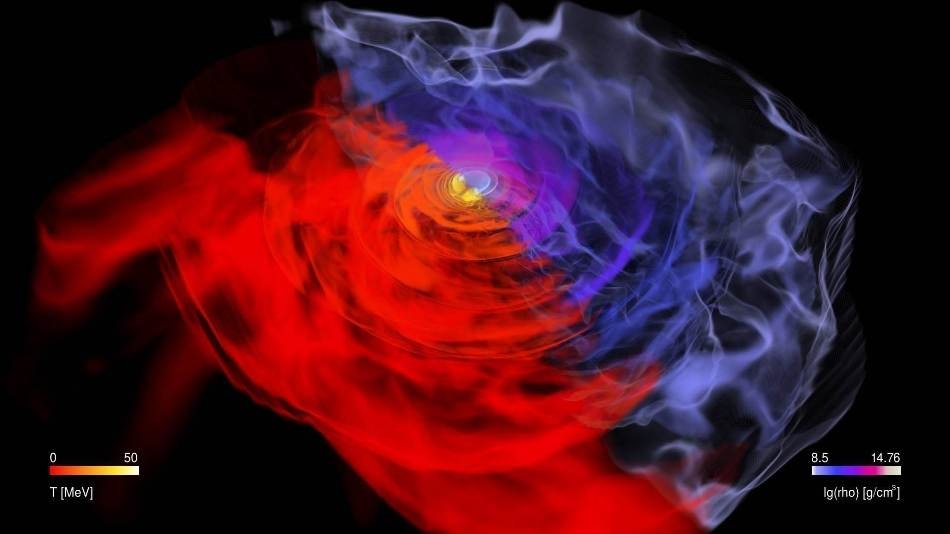Feb 14 2019
Quarks are the minuscule building blocks of matter that do not occur alone in nature. They are tightly bound forever within the neutrons and protons. But the core of neutron stars that weighs as much as the Sun but is the size of a city like Frankfurt is so dense that it is possible for a transition to occur from neutron matter to quark matter.
 Simulation of merging neutron stars calculated with supercomputers. Different colors show the mass density and the temperature some time after the merger has taken place and shortly before the object collapses to a black hole. Quarks are expected to form where the temperature and density are higher. (Image credit: C. Breu, L. Rezzolla)
Simulation of merging neutron stars calculated with supercomputers. Different colors show the mass density and the temperature some time after the merger has taken place and shortly before the object collapses to a black hole. Quarks are expected to form where the temperature and density are higher. (Image credit: C. Breu, L. Rezzolla)
This process is referred by physicists as a phase transition, which is analogous to the liquid-vapor transition that occurs in the case of water. Specifically, in principle, such a phase transition is feasible when neutron stars merge to form a highly massive meta-stable object with densities that exceed those of atomic nuclei and with temperatures 10,000 times higher than in the Sun’s core.
The measurement of gravitational waves radiated by merging neutron stars could offer insights into the possible phase transitions in outer space. It is possible for the phase transition to leave a characteristic signature in the gravitational-wave signal. Sophisticated supercomputers were used by the research teams from Frankfurt, Darmstadt, and Ohio (Goethe University/FIAS/GSI/Kent University) and also from Darmstadt and Wroclaw (GSI/Wroclaw University) to calculate how this signature would appear. They employed different theoretical models of the phase transition for this purpose.
If a phase transition occurs more following the actual merger, trivial amounts of quarks will slowly emerge throughout the merged object.
With aid of the Einstein equations, we were able to show for the first time that this subtle change in the structure will produce a deviation in the gravitational-wave signal until the newly formed massive neutron star collapses under its own weight to form a black hole.
Luciano Rezzolla, Professor for Theoretical Astrophysics, Goethe University
In the computer models developed by Dr Andreas Bauswein from GSI Helmholtzzentrum für Schwerionenforschung in Darmstadt, a phase transition already takes place directly following the merger—a quark matter core is formed inside the central object.
We succeeded to show that in this case there will be a distinct shift in the frequency of the gravitational wave signal. Thus, we identified a measurable criterion for a phase transition in gravitational waves of neutron star mergers in the future.
Dr Andreas Bauswein, GSI Helmholtzzentrum für Schwerionenforschung
It is not possible to measure all the details of the gravitational-wave signal by using the existing detectors. However, it will be feasible to observe them using futuristic detectors, as well as using a merger event that occurs relatively close to the Earth.
Two experiments offer a complementary strategy that answers the questions related to quark matter: Compressed nuclear matter can be synthesized through the collision of heavy ions at the existing HADES setup at GSI and at the proposed CBM detector at the Facility for Antiproton and Ion Research (FAIR), which is presently being built at GSI. During the collisions, it could be feasible to develop densities and temperatures that are analogous to those in a neutron-star merger. Both techniques offer a new understanding of the occurrence of phase transitions in nuclear matter and hence into its basic characteristics.